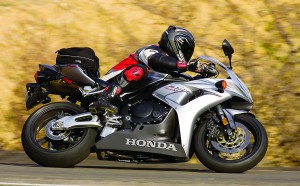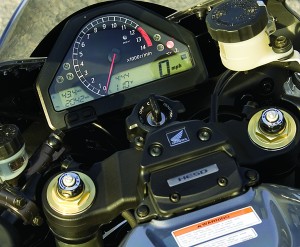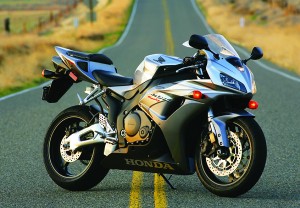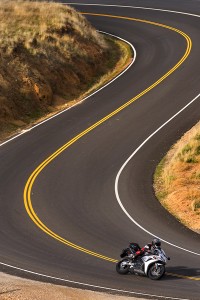It wouldn’t be fair to test a world-class sportbike as if it were a touring machine, so I’m not going to do that. But last time we checked, the CBR1000RR has a license plate, and it’s designed for the road and that’s where most people ride street-legal bikes. If you have to cover a lot of straight and wide to get to the winding and narrow, how does it work as a sport-touring machine?
For ’06 Honda made some significant tweaks to the CBR1000RR to reduce weight, add a little power and sharpen handling. But when I first folded my slightly aging 6-foot, 1-inch frame into the CBR’s snug cockpit, I was apprehensive about how suitable this machine would be for everyday use. Would it get me to work and back without chiropractic care?
As before, the engine starts immediately and is well behaved, but it sounds a little raspier, a bit “cammier” than before. Vibration is minimal, with just a light tingle at highway speeds between 4,500-5,500 rpm that’s typical of in-line fours. Tractability is still excellent; you can lug it down to 30 mph in sixth gear and accelerate away smoothly, but Honda upped horsepower about 3 percent, and in doing so moved the torque peak 1,500 revs higher. Initial acceleration isn’t quite as strong, but it’s been traded for a screaming top-end rush that takes you by surprise because the bottom end of the rev scale is so civilized. Once you hit five grand, the bike takes off like a politician trying to distance himself from a scandal. Grab a heaping handful of throttle and the front wheel lofts in the first three gears. A few times I did some big roll-on wheelies unintentionally. Really, officer.

Clutch pull is moderate which is nice in traffic, engagement is smooth yet solid and it’s easy to modulate. Gear changes are fast and sure, we never missed a shift and neutral can readily be found, even when idling in gear.
A bike this powerful is too fast to wring out on the street safely, so we obtained some valuable track time on California’s Buttonwillow Raceway Park. In addition to a full day of fast laps at the Button, I commuted for weeks on the CBR and then took it for a glorious ride down the coast to San Diego.
Our test bike was fitted with the latest Bridgestone BT-015s, which warm quickly with ample wet and dry grip, good feedback, and they held up well. Smooth throttle response is important and the CBR’s tip-in transition from idle is silken, which makes accelerating out of corners much easier. Braking is fantastic, even after hours of flogging. Suspension refinements translate into a firm but slightly more balanced feel between front and rear, with less chattering over ripples and bumps, little dive under braking and a more glued-to-the-road feeling. The 17-pound weight reduction can really be felt when flicking the bike from side to side in the tight stuff and the bike feels razor sharp and tracks beautifully through all sorts of turns. Honda’s Electronic Steering Damper disengages for easier maneuvering at lower velocities yet kept the wiggles under control at higher speeds.

The compact instrument cluster with digital speedo and analog tach is well placed and easy to read, even at night. It includes a coolant-temperature readout, clock and dual tripmeters. Coolant temperatures rise quickly in traffic and we saw 220 degrees after idling several minutes on a 75-degree day. Although it never hinted at boiling over and the thermostatically controlled fan kept us out of trouble, it is a cause for concern when triple-digit summer temperatures arrive. During testing, the low-fuel LED winked on between 124 and 135 miles. Mileage varied from 32.1 to 41.2 mpg, with an average of 37.6 mpg and an estimated range of 180 miles.
While it’s difficult to fault the bike mechanically, there are quite a few ergonomic issues. Under hard acceleration the slippery seat cover allows the rider to slide aft into the seat step, and under heavy braking the forward-slope will have you banging into the gas tank cover-unless you brace yourself strongly. Ouch! Honda changed the seat foam density slightly, but it’s still like fiberglass and had me dancin’ around after less than an hour in the saddle. Ouch again.

Wind protection is typical for a sportbike, which means it keeps the blast off your torso, and the lowers offer some protection to your legs, but your helmet is out in the breeze. Those clip-ons are too low for us old guys if you’re not on the track (check out Heli-Bars and GenMar products) and the elbow checkers (mirrors) are also too close together for most riders to see well behind. And did I mention how close the footpegs are to the seat?
The pillion seat might satisfy a naive passenger who doesn’t know any better, but most veteran copilots won’t like that wafer-thin cushion on a long ride-and did I mention how close those footpegs are to the seat? There’s enough room for a pack of cigarettes under the passenger seat if you leave the toolkit home, and the plastic faux gas tank cover prevents the use of magnetic tankbags. However, we found a conventional tankbag, seatbag and soft saddlebags from Chase Harper that allowed us to carry a surprising amount of gear. We were able to stow enough stuff for several days on the road and the heat from the muffler didn’t melt my secret stash of chocolate bars.

Considering the bike’s sporting role and capabilities, the CBR is well mannered and able to be ridden in a civilized way on the street, yet ready to flog on a track day with a moment’s notice. But while this hyper-sports model brings good rideability, incredible performance, quality and reliability together at a reasonable price, it does leave a little to be desired for long-distance sport touring.







